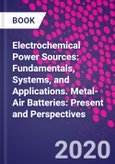Electrochemical Power Sources: Fundamentals, Systems, and Applications - Metal-Air Batteries: Present and Perspectives
provides researchers, instructors, and students in electrochemistry, material science and environmental science; industry workers in cell manufacturing; and government officials in energy, environmental, power supply, and transportation with a valuable resource covering the most important topics of metal-air batteries and their uses.
Please Note: This is an On Demand product, delivery may take up to 11 working days after payment has been received.
Table of Contents
1. Introduction General features of Metal-Air Batteries 2. Components for Metal-Air Batteries 3. Primary Zinc-Air Batteries 4.�Alternative Chemistries in Metal-Air Batteries� 5. Secondary Zinc-Air Batteries Electrically�Rechargeable 6. Secondary Zinc-Air Batteries�- Mechanically Rechargeable 7. Secondary Lithium- and Other Alkali- Air Batteries 8.�Alternative Chemistries in Secondary Metal-Air Batteries� 9. Model and Simulation 10. Applications and Markets
Authors
Hajime Arai Tokyo Institute of Technology, Yokohama, Japan. Hajime Arai is a professor at Tokyo Institute of Technology, Yokohama, Japan. He has 30 years of experience in battery including metal-air and solid oxide fuel cells and battery analysis using synchrotron beamlines. J�rgen Garche Fuel Cell and Battery Consulting, Ulm, Germany.J�rgen Garche, graduated in chemistry at the Dresden University of Technology (DTU) in Germany in 1967. He was awarded his PhD in theoretical electrochemistry in 1970 and his habilitation in applied electrochemistry in 1980 from the same university. He worked at the DTU in the Electrochemical Power Sources Group for many years in different projects, mainly related to conventional batteries, before he moved 1991 to the Centre for Solar Energy and Hydrogen Research (ZSW) in Ulm, where he was, until 2004, the Head of the Electrochemical Energy Storage and Energy Conversion Division.
He was Professor of Electrochemistry at Ulm University and Guest Professor at Shandong University - China, 2005, Sapienca University Roma - Italy, 2009, 2013, 2016, and 2023, TUM-CREATE - Singapore, 2014, 2015, 2016- 2016, Dalian Institute of Chemical Physics - China, 2016, CNR Institute for Advanced Energy Technologies, Messina - Italy, 2019. After he retired from the ZSW he founded in 2004 the consulting firm Fuel Cell and Battery Consulting (FCBAT). Since 2015 he is senior professor at Ulm University. He has published more than 300 papers, 10 patents, and 11 books, among others as editor-in-chief of the first edition of Encyclopedia of Electrochemical Power Sources. He is listed in "World's most Influential Scientific Minds� by Thomas Reuters (2014) and in the book "Profiles of 93 Influential Electrochemists� (2015).
Luis C. Colmenares CIDETEC Energy Storage, Donastia-San Sebasti�n, Spain. Luis C. Colmenares is an R&D professional at CIDETEC Energy Storage, Gipuzcoa, Spain. He has more than 15 years of experience in material R&D for fuel cells, electrolyzers, and metal-air batteries, particularly zinc-based







